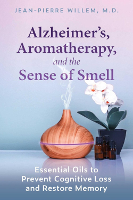
Image by reenablack
Smell is a passive sense (you cannot choose what you are smelling), for which reason it was once considered minor and a little bit coarse— furthermore, it is dogs that sniff! In 2014, a study published in the magazine Science showed for the first time that a human being can detect a trillion odors (Bushdid et al. 2014). That is immense.
The human genome contains four hundred genes devoted to the sense of smell. As a comparison, there are only four genes for color. It is a very complex palette that has been shaped by human evolution. The sense of smell corresponds to the most ancient part of our history. Before being able to hear, see, and even think, beings felt and communicated by the sense of smell. When we humans were all still huntergatherers, this sense allowed us to identify an edible food or, to the contrary, protect us from danger.
A DOG'S OPTIMIZED MUZZLE
A dog’s muzzle corresponds to the human nose. But a dog’s sensitivity to odors is from 1,000 to 100,000 times better than that of a human being. This is due primarily to the fact that a dog has fifty million to two hundred million neuroreceptors carpeting its nostrils, compared to the six million in a human’s nose.
In addition, when we breathe in air, what we are feeling, and what we are breathing in, form part of the same flow. Dogs have a membrane inside their muzzles that allows them to separate the airflow into two parts: one part flows toward the lungs, which permits respiration, and the other flows upward, toward the receptor-covered olfactory epithelium, which permits smell.
While humans breathe in and out through the same channel, dogs exhale through slits at the sides of their muzzles, which creates whirlwinds of air that strengthen the attraction of new odors into the nostrils.
Dogs also have another active olfactory organ: the vomeronasal organ, or Jacobson’s organ, which is present in all mammals but is found in a reduced form in humans. Located behind the incisors above the soft palate, this organ captures pheromones and is therefore useful in the choice of a sexual partner, for example. This olfactory organ would permit dogs to smell the pheromones we emit with particular emotions (sadness, joy, stress, anger) and even to detect diseases or a pregnancy.
The regions of the brain that are dedicated to olfaction are more developed in dogs (and in cats) than in the human being, and they are more apt at identifying odors due to their much more elaborate olfactory system. Their sense of smell is the first alert in the presence of danger, prey, or potential sexual partner.
A dog’s nose serves it like a compass intended to ensure the essential—namely, the struggle for survival, reproduction, and adaptation. It was the same for our ancestors during the time before the discovery of fire and cooking.
ANATOMY OF A DOG’S NOSE
One advantage dogs, and especially dogs with long noses, have over many other animals is that there is a lot of space in the nasal cavity for a large surface of olfactory epithelium. A German shepherd or Belgian sheepdog, for example, has up to two hundred square centimeters of olfactory mucous membrane, which allows it to house one hundred times more olfactory neurons than a human being.
Note that dogs (along with mice, rats, cows, and opossums) are among those mammals that have approximately one thousand smell receptor genes in their genome. It’s 872, to be exact. With this kind of equipment, it’s no wonder it performs so highly.
HOW DOES THE DOG’S SENSE OF SMELL FUNCTION?
A dog’s unique sense of smell influences the daily behavior of the animal and plays an important role in the hunt for food, when a threat is present, or when it is looking to reproduce. Dogs have two means of perceiving odors: the nasal tract and the retronasal pathway.
The nasal tract has priority. The air breathed by the dog, which carries odor molecules, travels through the nasal cavity. Only 7 percent of the air the dog breathes in reaches the olfactory apparatus.
The retro-nasal pathway is next. Some odor molecules are transmitted directly to the olfactory apparatus during exhalation or in the presence of food or urine. When a dog perceives an odor, it sniffs the source of the odor with several accelerated inhalations and exhalations, which allows the dog to make sure there is better contact between the odor molecules and the olfactory mucous membrane.
The retained odor molecules are integrated by the cells of the olfactory epithelium, from where they reach the neurons that interpret the smell and transmit its message to the dog’s brain. The animal is then able to interpret its surroundings or even follow a trail. Whether the trail is recent, at a distance, or several days old, this canine function works better than GPS.
THE MECHANISM IN HUMAN BEINGS
Human neuroreceptors, whose life span is four days, are capable of dissolving the odor molecules suspended in the air that has been inhaled and analyzing them. The message is then transmitted to the most archaic part of the brain, which we have in common with all animals. From there, the information is relayed to other cerebral layers to be integrated in the entire perception of a situation. It is then judged as more or less pleasant and compared to past emotional and behavioral reactions before leading to an instinctive reaction or decision.
Scent touches the deepest part of our subconscious mind while also mobilizing all brain functions. We know full well that there is nothing like an unpleasant odor to provoke an instinctive reaction of disgust or rejection. Moreover, the olfactory information sent to the two hemispheres constructs a suspension bridge between the logical, rational, and analytic thought of the left brain and the analogical, symbolic, and intuitive thought of the right brain.
THE IMMENSE OLFACTORY CAPACITIES OF DOGS
A dog’s powerful sense of smell is invaluable to human beings, who have used it to their advantage in a variety of ways. It allows dogs:
✦ to immerse themselves in their environment;
✦ to identify the presence of other dogs and other animals, including human beings;
✦ to pursue reproduction (when a male dog smells the odor released by a female dog in heat);
✦ to find food;
✦ to mark their territory, which is also an important means of communication;
✦ to rescue people when there are earthquakes, avalanches, and other disasters in which they are buried alive;
✦ to hunt for explosives or drugs; and
✦ to track down a missing person.
MEDICAL FEATS
People in the medical community should focus their attention on dogs’ ability to diagnose disease. Every day, more discoveries are made concerning their ability to identify illnesses like cancer as well as to prevent an imminent attack of epilepsy or hypoglycemia. Some dogs have the ability to identify such attacks fifteen minutes before they happen, which allows their owners to take precautions and prevent any aggravating circumstances surrounding these episodes. In the case of cancer (mainly ovarian, lung, and melanomas), dogs can provide a diagnosis more efficiently and earlier than medical professionals.
Moreover, the presence of dogs (and cats) in nursing homes and memory care centers has a soothing effect on the agitation of patients with Alzheimer’s and related disorders. These individuals, who no longer grasp the meaning of words, are being reached through their archaic corporeal sensitivity. The immediate, authentic, and warm contact with an animal gives them profound reassurance. Their heart rates stabilize, and they temporarily enjoy a moment of true connection, accompanied sometimes by fragments of memories that were thought lost once and for all because of the neurodegenerative disorder. The dog they pet can encourage processes of mental attachment that have been totally mud-dled.
For those who are less dependent, the animal can restore a social bond, offering them a break from the terrifying solitude that comes with the seclusion of old age. The animal’s life-giving warmth pushes the anguish of death back into the distance.
THE CAT’S STORY
The sense of smell is particularly useful to cats for several reasons. It is how they identify their territory, that of others (social role), and potential enemies or prey, and, most importantly, smell has an effect on their appetite. With its sense of smell, a cat can quickly distinguish food that is rotting from that which is edible; partial or total loss of the sense of smell can lead a cat straight into anorexia.
These traits show that a cat’s sense of smell is clearly more developed than ours. It is, in fact, one hundred times better and is even up to the task of recognizing several thousand odors thanks to its two hundred million olfactory terminals.
When a cat’s nose is moist, it means that in the space of an instance it has detected an interesting smell. The moisture comes from activation of the Bowman’s glands, which allow a cat to enter into a state of full olfactory evaluation of its environment.
In the same vein, a cat’s sense of taste is slightly less developed compared to that of a human being. An adult cat has only 250 taste buds, while an adult human has about 10,000.
So here is something for humans to ponder and to help them see their cat with new eyes—but therefore differently. In any event, as Arthur Schopenhauer observed, “If you stroke a cat, it will purr; and, as inevitably, if you praise a man, a sweet expression of delight will appear on his face.”
THE DOG-CAT-HUMAN ANALOGY
Dogs can sense when a human is scared, but it is not as simple as that. Dogs interpret the feeling of fear thanks to the odors we release. When we are scared, we sweat more and our body language changes; our movements are different and more nervous, and our muscles contract more. A dog can smell this, see this, perceive this, and understand this.
When Paul Broca, the French physician who is famous for his categorization of the brain into distinct areas in 1879, identified the olfactory bulb in humans, he noted that its size, in relative volume, was smaller than that of other mammals like the dog or rat. So, he theorized, humans have only an impoverished sense of smell at their disposal. This statement was advanced again by Sigmund Freud, who saw this deficiency of our species as comparable to a mental disease!
Even so, our memory works primarily through our olfactory system. All the events connected to a fragrance are recorded from the first day of our life. Scents can recall images, situations, or experiences we’ve had and take us back even into our youngest childhood.
The sense of smell has no sense of time. Through a fragrance, we can feel a past event again as intensely as we experienced it the first time. This effect, also known as the Proust phenomenon, was described quite well by that author in his Remembrance of Things Past. In it, he explains how a childhood memory was brought back to the surface by the smell of a madeleine dipped in tea. At that very moment, this memory gave him a feeling of protection and intense happiness. This scent was transformed into a positive mooring for him.
Copyright 2022. All Rights Reserved.
Adapted with permission of the publisher,
Healing Arts Press, an imprint of Inner Traditions Intl.
Article Source:
BOOK: Alzheimer's, Aromatherapy, and the Sense of Smell
Alzheimer's, Aromatherapy, and the Sense of Smell: Essential Oils to Prevent Cognitive Loss and Restore Memory
by Jean-Pierre Willem.
 Offering a hands-on and medication-free way to help those suffering from Alzheimer’s, this guide provides a way for Alzheimer’s patients and their families to recover the joy of living again.
Offering a hands-on and medication-free way to help those suffering from Alzheimer’s, this guide provides a way for Alzheimer’s patients and their families to recover the joy of living again.
Citing years of clinical evidence, Jean-Pierre Willem, M.D., shows how Alzheimer’s is critically bound with the sense of smell. Sharing the striking results seen in French hospitals and senior living homes where aromatherapy has been used as a therapy for Alzheimer’s for more than 10 years, Dr. Willem details how to use essential oils to stimulate memory, prevent cognitive loss, and counter the isolation, withdrawal, and depression these patients are likely to feel.
For more info and/or to order this book, click here. Also available as a Kindle edition.
 About the Author
About the Author
Jean-Pierre Willem, M.D., is the founder of the French Barefoot Doctors movement, which brings traditional healing techniques back into clinical settings. The author of several books in French on natural healing for degenerative diseases, he lives in France.
Books by this Author (many in their original French language).
























